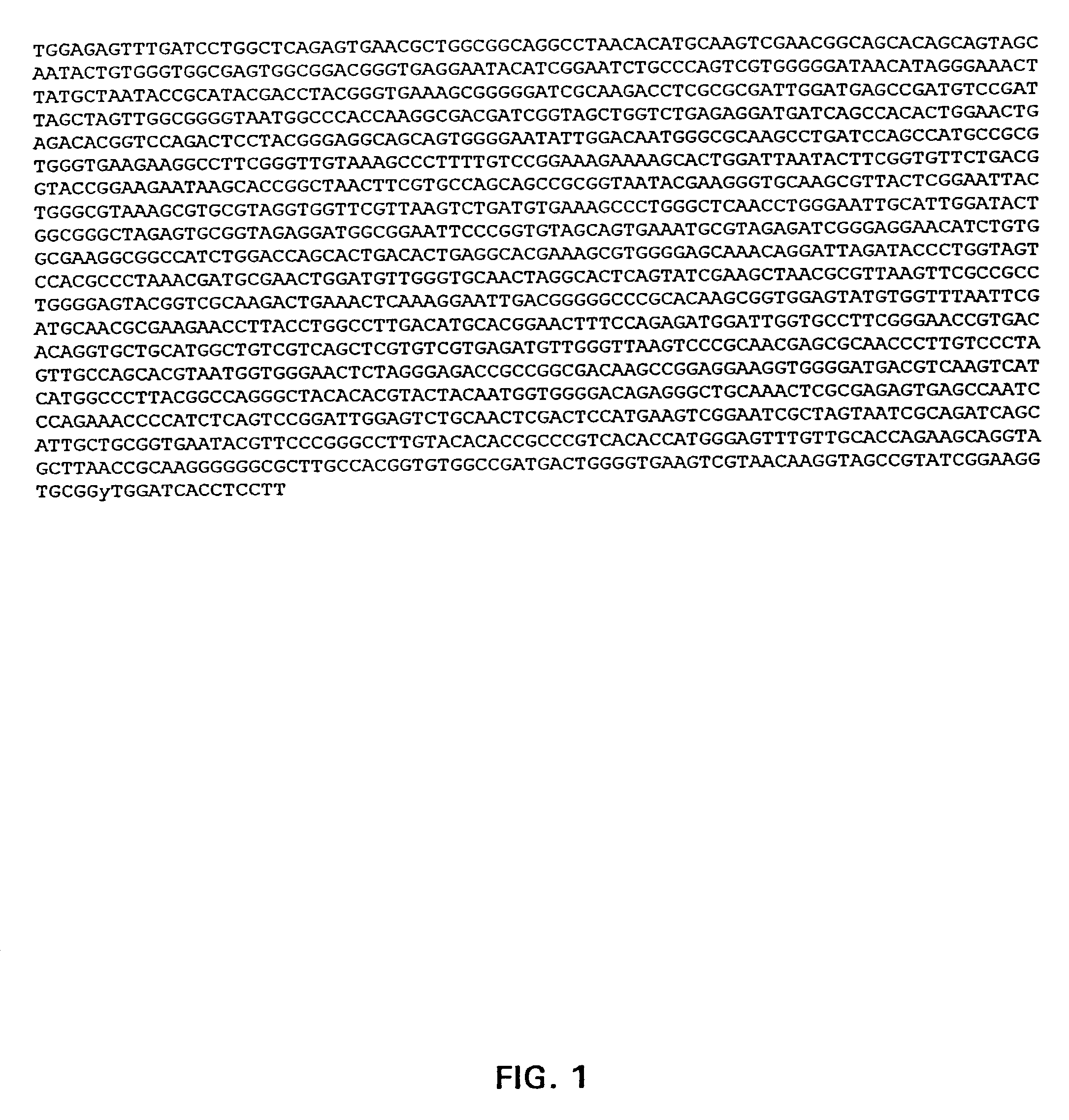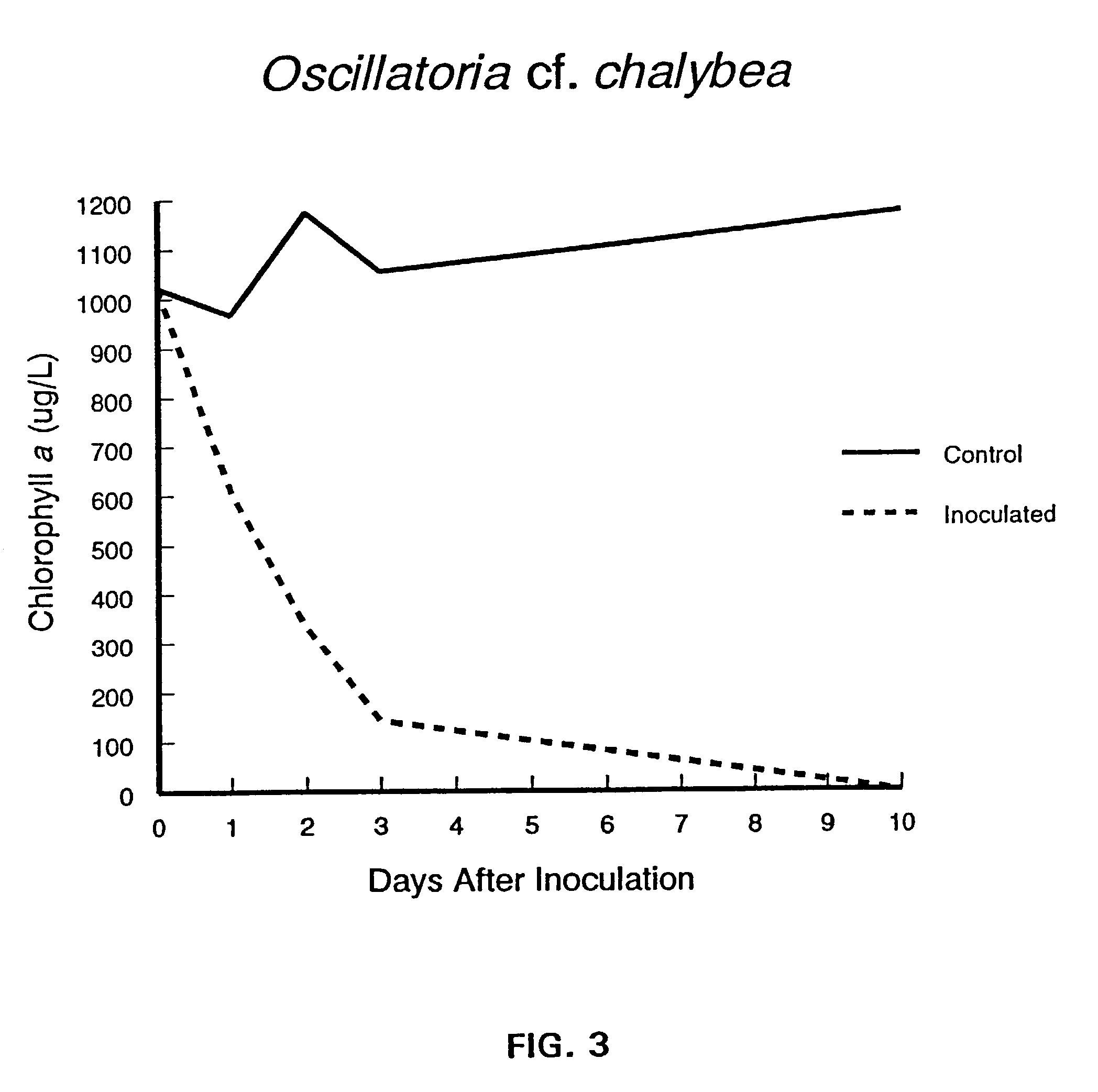Bacterium NRRL B-30043 for controlling algae
a technology of algae and microorganisms, applied in the direction of bacteria-based processes, biocide, enzymology, etc., can solve the problems of unpalatable fish, affecting the quality of fish, so as to reduce control the incidence of organisms, and manage the water quality
- Summary
- Abstract
- Description
- Claims
- Application Information
AI Technical Summary
Benefits of technology
Problems solved by technology
Method used
Image
Examples
example 1
Isolation of Bacterium SG-3
[0077]The Bacterium SG-3 of the invention was isolated according to previously described procedures (U.S. Pat. No. 5,739,019 to Walker et al.). Specifically, filaments of Oscillatoria cf. chalybea growing as shake flask cultures were immobilized in gel beads of calcium alginate. The immobilized Oscillatoria cf. chalybea was placed in small bags constructed from fiberglass window screen. The tops of the bags were secured with monofilament fishing line. The bags containing the beads were placed in a sampling device constructed of perforated plastic pipe (3.2×30 cm) that was capped on each end, with one cap threaded for ease of removal. After incubation at a sampling site (3 to 5 days), such as a fresh water pond, the beads of immobilized cyanobacterium were returned to the laboratory, removed from the sampling device, and placed into cultures of Oscillatoria cf. chalybea. The presence of lytic agents was indicated as zones of clearing in lawns or by destruct...
example 2
Determination of the Growth Curve for the Bacterium SG-3
[0079]Growth rates of the Bacterium SG-3 in shake flask cultures were quantified by determination of the number of plaque forming units (PFU). (FIG. 2) Sterile growth medium (100 ml in each of three 250 ml flasks) was aseptically inoculated with 0.1 ml from a culture of the bacterium that was 72 h old. The numbers of PFU per ml in each of three flasks were determined at 0, 24, 48, 72, 96, 120, and 144 h after inoculation. Serial dilutions of bacterial cultures were made in BG-11 medium. The growth medium was BG-11 supplemented with 6 g / L tryptic soy broth, and the host was Anabaena sp. (ATCC 27898). Values are averages of three replications.
[0080]Lawns of Oscillatoria cf. chalybea were difficult to prepare because of the growth characteristics of this cyanobacterium. However, the bacterium formed plaques in lawns of Anabaena sp. (ATCC 27898), and this isolate was used to assay for PFU.
[0081]The numbers of PFU were determined us...
example 3
Evaluation of the Response of Selected Cyanobacteria and Algae to the Bacterium SG-3
[0082]Shake flask cultures (100 ml per 250 ml flask) of cyanobacteria and algae (Table 1) were inoculated with 1 ml of a Bacterium SG-3 culture that was 72 h old. Seven days after inoculation, chlorophyll a determinations were used to measure the response to Bacterium SG-3. Three shake flask cultures were inoculated for each alga or cyanobacterium. Reduction (%) of chlorophyll a was based on data from three controls that received 1 ml of growth medium only.
[0083]Chlorophyll a determinations at 0, 1, 2, 3, and 10 days following inoculation were used to evaluate the response of Oscillatoria cf. chalybea, Oscillatoria sp. (ATCC 29205), and Anabaena sp. (ATCC 27898) to the bacterium. Shake flask cultures (100 ml per 250 ml flask) were each inoculated with 1 ml from a 72 h bacterial culture. Each treatment was replicated three times, and each experiment included controls that received 1 ml of growth mediu...
PUM
| Property | Measurement | Unit |
|---|---|---|
| temperature | aaaaa | aaaaa |
| water temperature | aaaaa | aaaaa |
| temperature | aaaaa | aaaaa |
Abstract
Description
Claims
Application Information
 Login to View More
Login to View More - R&D
- Intellectual Property
- Life Sciences
- Materials
- Tech Scout
- Unparalleled Data Quality
- Higher Quality Content
- 60% Fewer Hallucinations
Browse by: Latest US Patents, China's latest patents, Technical Efficacy Thesaurus, Application Domain, Technology Topic, Popular Technical Reports.
© 2025 PatSnap. All rights reserved.Legal|Privacy policy|Modern Slavery Act Transparency Statement|Sitemap|About US| Contact US: help@patsnap.com



